Assessment of Bearing Capacity and Stiffness in New Steel Sets Used for Roadway Support in Coal Mines
Abstract
:1. Introduction
2. Materials and Methods
2.1. Full-Sacle Sets Used In Situ
2.2. Scaled Sets Used in Experiments
2.3. Scaled Sets Loading State in Experiments
2.4. Deformation and Stress Monitor in Experiments
3. Results
3.1. Displacement in Experiments
3.1.1. Horizontal Displacement in Top Arch
3.1.2. Vertical Displacement in Bottom Arch
3.2. Stresses in Experiments
3.2.1. Stresses in Top Arch
3.2.2. Stresses in Floor Beam
3.2.3. Stresses in Roof Beam
4. Discussion
5. Conclusions
Acknowledgments
Author Contributions
Conflicts of Interest
References
- Butscher, C.; Huggenberger, P.; Zechner, E. Impact of tunneling on regional groundwater flow and implications for swelling of clay-sulfate rocks. Eng. Geol. 2011, 117, 198–206. [Google Scholar] [CrossRef]
- Loui, J.P.; Jhanwar, J.C.; Sheorey, P.R. Assessment of roadway support adequacy in some Indian manganese mines using theoretical in situ stress estimates. Int. J. Rock Mech. Min. Sci. 2007, 44, 148–155. [Google Scholar] [CrossRef]
- Nierobisz, A. Investigation of mine roadway support load during seismic events. J. Min. Sci. 2012, 48, 298–307. [Google Scholar] [CrossRef]
- Ulusay, R.; Aydan, Ӧ.; Geniş, M.; Hisataka, T. Stability assessment of avanos underground congress centre (Cappadocia, Turkey) in soft tuffs through an integrated scheme of rock engineering methods. Rock Mech. Rock Eng. 2013, 46, 1303–1321. [Google Scholar] [CrossRef]
- Schwingenschloegl, R.; Lehmann, C. Swelling rock behaviour in a tunnel: NATM-support vs. Q-support-A comparison. Tunnel. Undergr. Space Technol. 2009, 24, 356–362. [Google Scholar] [CrossRef]
- Shen, B.T. Coal Mine Roadway Stability in Soft Rock: A Case Study. Rock Mech. Rock Eng. 2013, 47, 2225–2238. [Google Scholar] [CrossRef]
- Szwilski, A.B. Experience with mine roadway steel arch supports in the United Kingdom. CIM Bull. 1979, 72, 92–98. [Google Scholar]
- Choquet, P. Design of steel arch supports for gate roadways. CIM Bull. 1986, 79, 88–96. [Google Scholar]
- Baxter, N.G.; Watson, T.P.; Whittaker, B.N. Study of the application of T-H support systems in coal mine gate roadways in the UK. Min. Sci. Technol. 1990, 10, 167–176. [Google Scholar] [CrossRef]
- Kang, H.P. Support technologies for deep and complex roadways in underground coal mines: A review. Int. J. Coal Sci. Technol. 2014, 1, 261–277. [Google Scholar] [CrossRef]
- Bayerl, M.; Danzebrink, B.; Thyrock, K.; Opolony, K.; Gollnick, I. Application of Hilti one step bolts for roadway support in German deep coal mines. In Proceedings of the 28th International Conference on Ground Control in Mining, Morgantown, WV, USA, 28 July 2009. [Google Scholar]
- Kang, H.P.; Lin, J.; Wu, Y.Z. Development and applications of rock bolting materials for coal mine roadways. In Proceedings of the 30th Annual International Pittsburgh Coal Conference, Beijing, China, 15–18 September 2013. [Google Scholar]
- Wu, Y.Z.; Kang, H.P.; Wu, J.X.; Fan, R.X. Development and application of mine prestressed steel bars supporting technology. Chin. J. Rock Mech. Eng. 2015, 34, 3230–3237. [Google Scholar]
- Li, S.C.; Wang, Q.; Li, W.T.; Wang, D.C.; Li, Z.; Jiang, B.; Wang, H.P.; Wang, H.T. Comparative field test study of pressure relief anchor box beam support system in deep thick top coal roadway. Chin. J. Rock Mech. Eng. 2012, 31, 656–666. [Google Scholar]
- He, M.C.; Gong, W.L.; Wang, J.; Qi, P.; Tao, Z.G.; Du, S.; Peng, Y.Y. Development of a novel energy-absorbing bolt with extraordinarily large elongation and constant resistance. Int. J. Rock Mech. Min. Sci. 2014, 67, 29–42. [Google Scholar] [CrossRef]
- Jeong, Y.Y.; Kang, H.M.; Choi, S.H.; Cho, S.H. Dynamic expansion rock bolt for rapid installing in rocks. Geosyst. Eng. 2015, 18, 85–91. [Google Scholar] [CrossRef]
- Gao, Y.F.; Wang, B.; Wang, J.; Li, B.; Xing, F.; Wang, Z.G.; Jin, T.L. Test on structural properties and application of concrete-filled steel tube support of deep mine and soft rock roadway. Chin. J. Rock Mech. Eng. 2010, 29, 2604–2609. [Google Scholar]
- Li, S.C.; Shao, X.; Jiang, B.; Wang, Q.; Wang, F.Q.; Ren, Y.X.; Wang, D.C.; Ding, G.L. Study of the mechanical characteristics and influencing factors of concrete arch confined by square steel set in deep roadways. J. China Univ. Min. Technol. 2015, 44, 400–408. [Google Scholar]
- Srivastava, L.P.; Singh, M. Effect of fully grouted passive bolts on joint shear strength parameters in a blocky mass. Rock Mech. Rock Eng. 2015, 48, 1197–1206. [Google Scholar] [CrossRef]
- Wang, L.G.; Zhang, J.; Li, H.L. A creep analysis of a bolt-grouting support structure within a soft rock roadway. J. China Univ. Min. Technol. 2009, 38, 607–612. [Google Scholar]
- Steiner, W.; Kaiser, P.K.; Spaun, G. Role of brittle fracture on swelling behaviour of weak rock tunnels: Hypothesis and qualitative evidence Sprödbruch in wenig festem Fels als Auslöser von Quellvorgängen: Beobachtungen und Analysen. Geomechanik Und Tunnelbau 2010, 3, 583–596. [Google Scholar] [CrossRef]
- Bilir, M.E. Swelling problems and triaxial swelling behavior of claystone: A case study in Tire, Turkey. Sci. Res. Essays 2011, 6, 1106–1116. [Google Scholar] [CrossRef]
- Chertkov, V.Y.; Ravina, I. Networks originating from the multiple cracking of different scales in rocks and swelling soils. Int. J. Fract. 2004, 128, 263–270. [Google Scholar] [CrossRef]
- Ghiasi, V.; Ghiasi, S.; Prasad, A. Evaluation of tunnels under squeezing rock condition. J. Eng. Des. Technol. 2012, 10, 168–179. [Google Scholar] [CrossRef]
- Schädlich, B.; Marcher, T.; Schweiger, H.F. Application of a constitutive model for swelling rock to tunneling. Geotech. Eng. 2013, 44, 47–54. [Google Scholar]
- Serafeimidis, K.; Anagnostou, G. On the time-development of sulphate hydration in anhydritic swelling rocks. Rock Mech. Rock Eng. 2013, 46, 619–634. [Google Scholar] [CrossRef]
- Mutschler, T.; Kramar, U.; Vergara, M.R.; Triantafyllidis, T. Influence of hematite coating on the activation of the swelling potential of smectite-bearing rocks. Rock Mech. Rock Eng. 2013, 46, 835–847. [Google Scholar] [CrossRef]
- Li, Q.H.; Shi, W.P.; Yang, R.S. Deformation mechanisms in a coal mine roadway in extremely swelling soft rock. SpringerPlus 2016, 5, 1–13. [Google Scholar] [CrossRef] [PubMed]
- Li, Q.H.; Shi, W.P.; Qin, Z.C. Effect of bolting on roadway support in extremely weak rock. SpringerPlus 2016, 5, 1–18. [Google Scholar] [CrossRef] [PubMed]
- Sun, X.M.; Wu, X.; He, M.C. Differentiation and grade criterion of strong swelling soft rock. Chin. J. Rock Mech. Eng. 2005, 24, 128–132. [Google Scholar]
- Aksoy, C.O.; Ogul, K.; Topal, I.; Ozer, S.C.; Ozacar, V.; Posluk, E. Numerical modeling of non-deformable support in swelling and squeezing rock. Int. J. Rock Mech. Min. Sci. 2012, 52, 61–70. [Google Scholar] [CrossRef]
- Jiao, Y.Y.; Song, L.; Wang, X.Z.; Adoko, A.C. Improvement of the U-shaped steel sets for supporting the roadways in loose thick coal seam. Int. J. Rock Mech. Min. Sci. 2013, 60, 19–25. [Google Scholar] [CrossRef]
- Jin, C.Y. Mining Design; Contemporary Chinese Audio and Video Publishing House: Beijing, China, 2004; p. 136. [Google Scholar]
- Kaiser, P.K.; Mccreath, D.R. Rock Support in Mining and Underground Construction; A.A. Balkema: Rotterdam, The Netherlands, 1992; pp. 557–567. ISBN 9054100443. [Google Scholar]

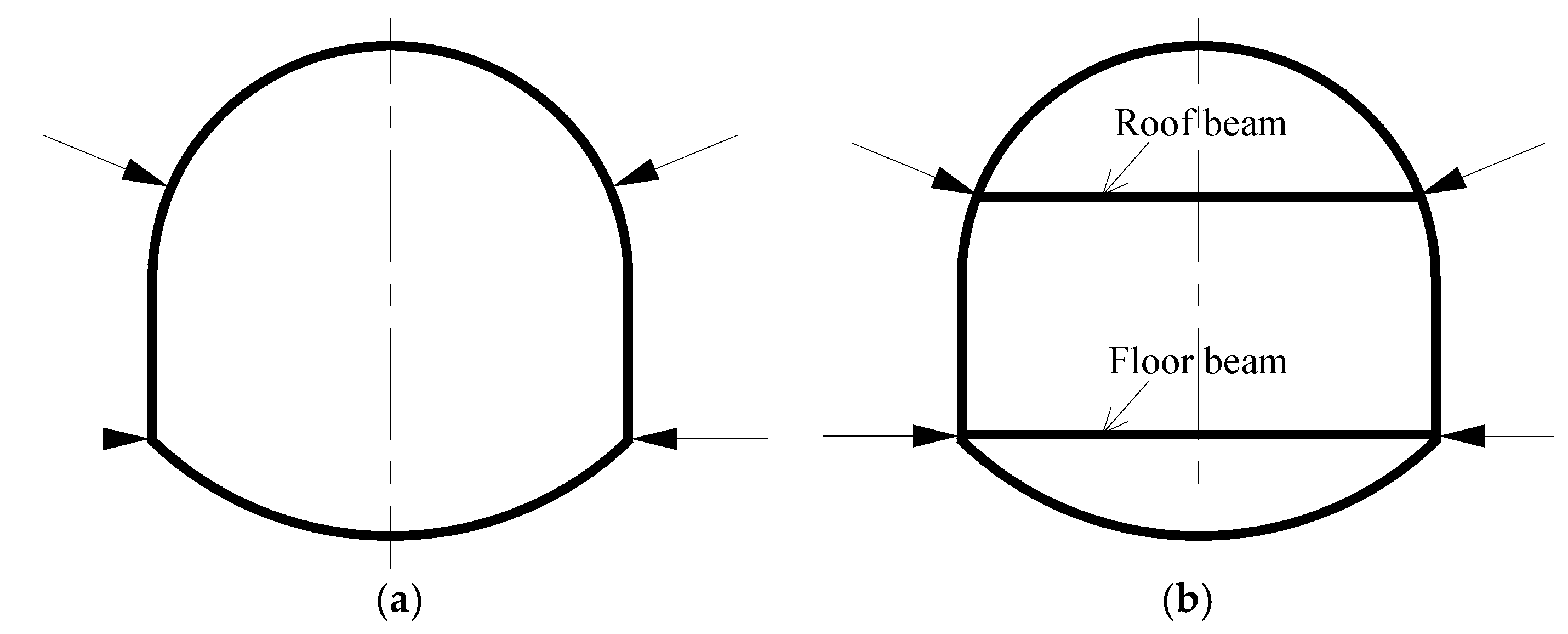

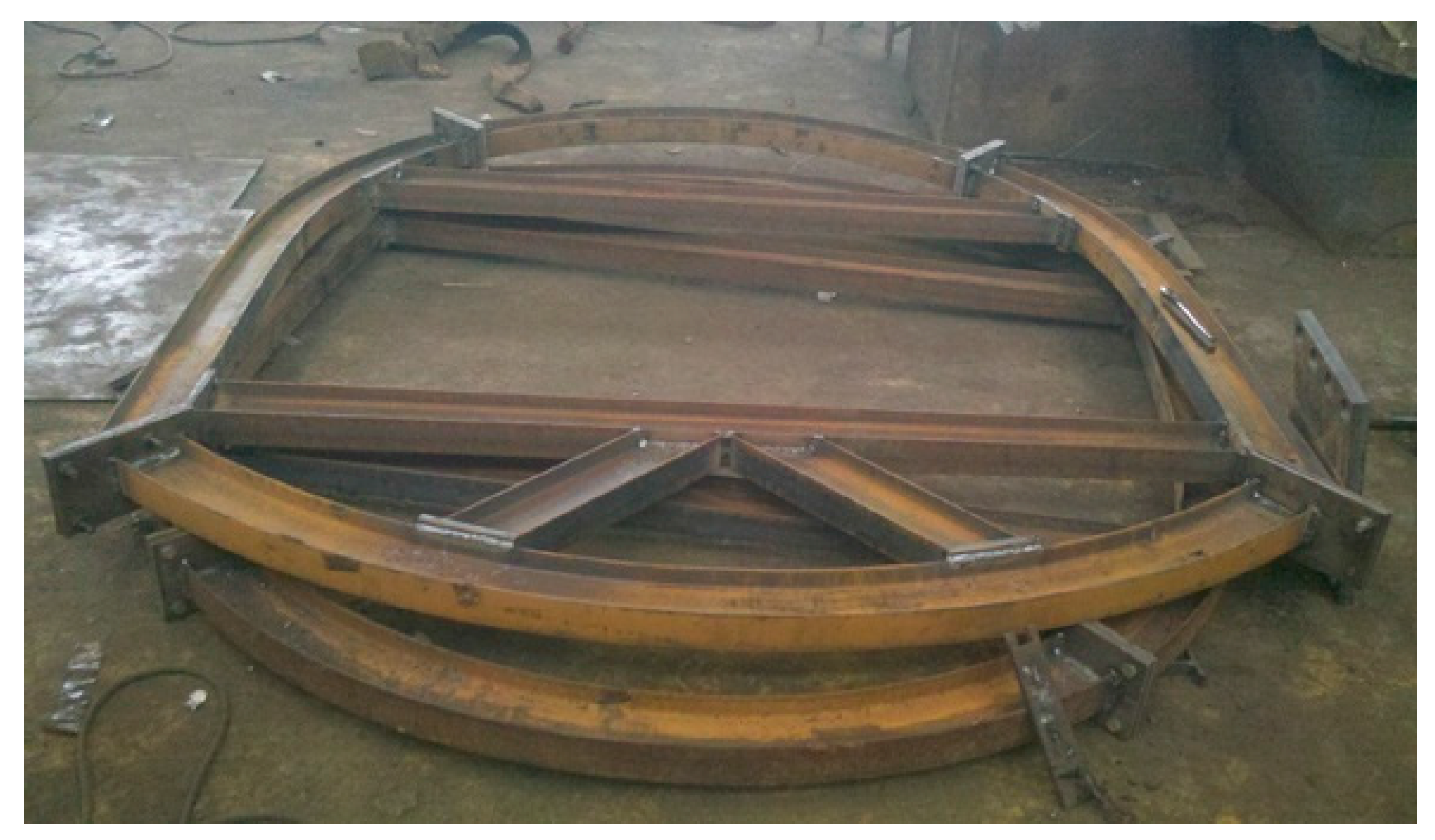



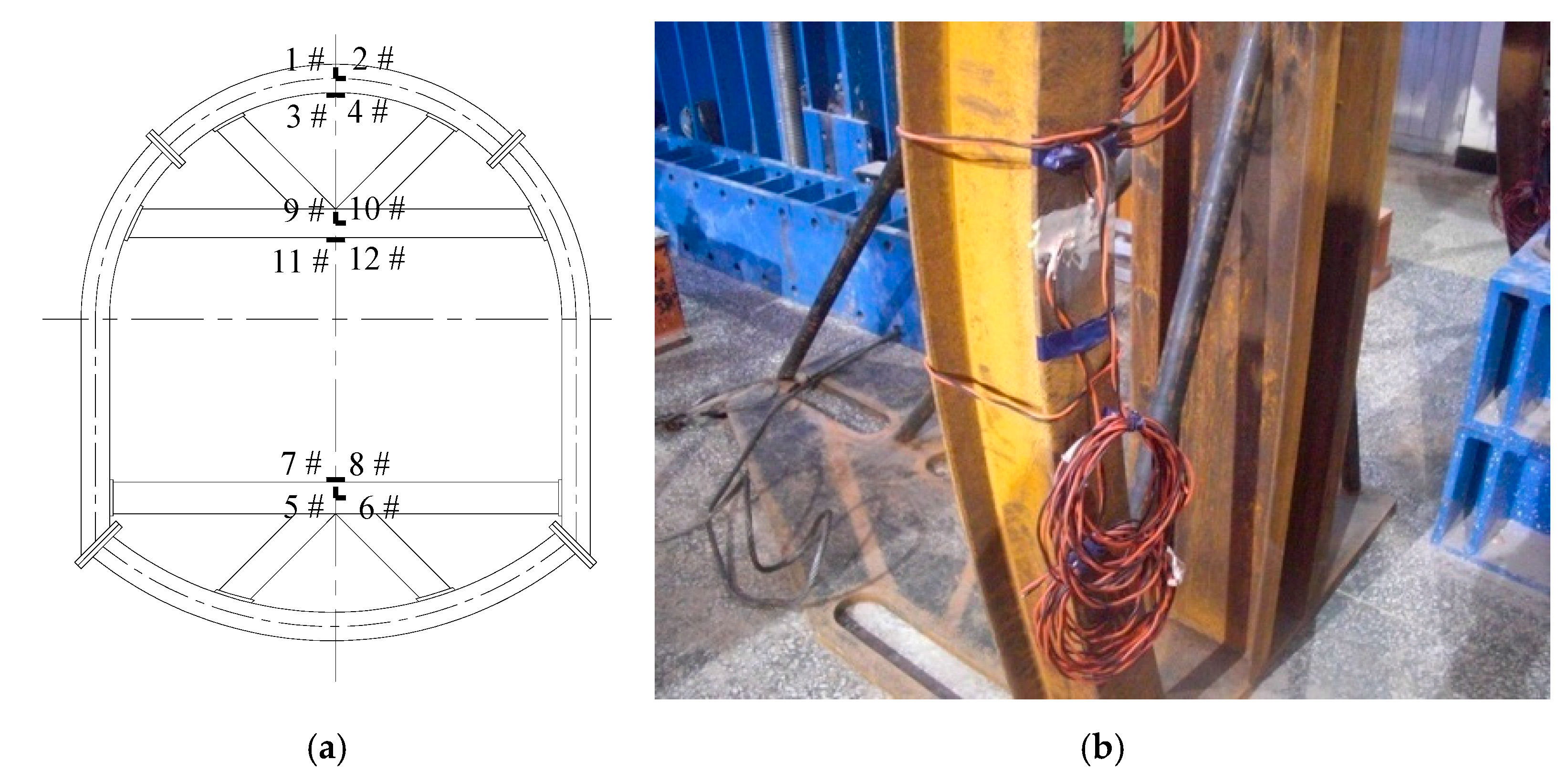
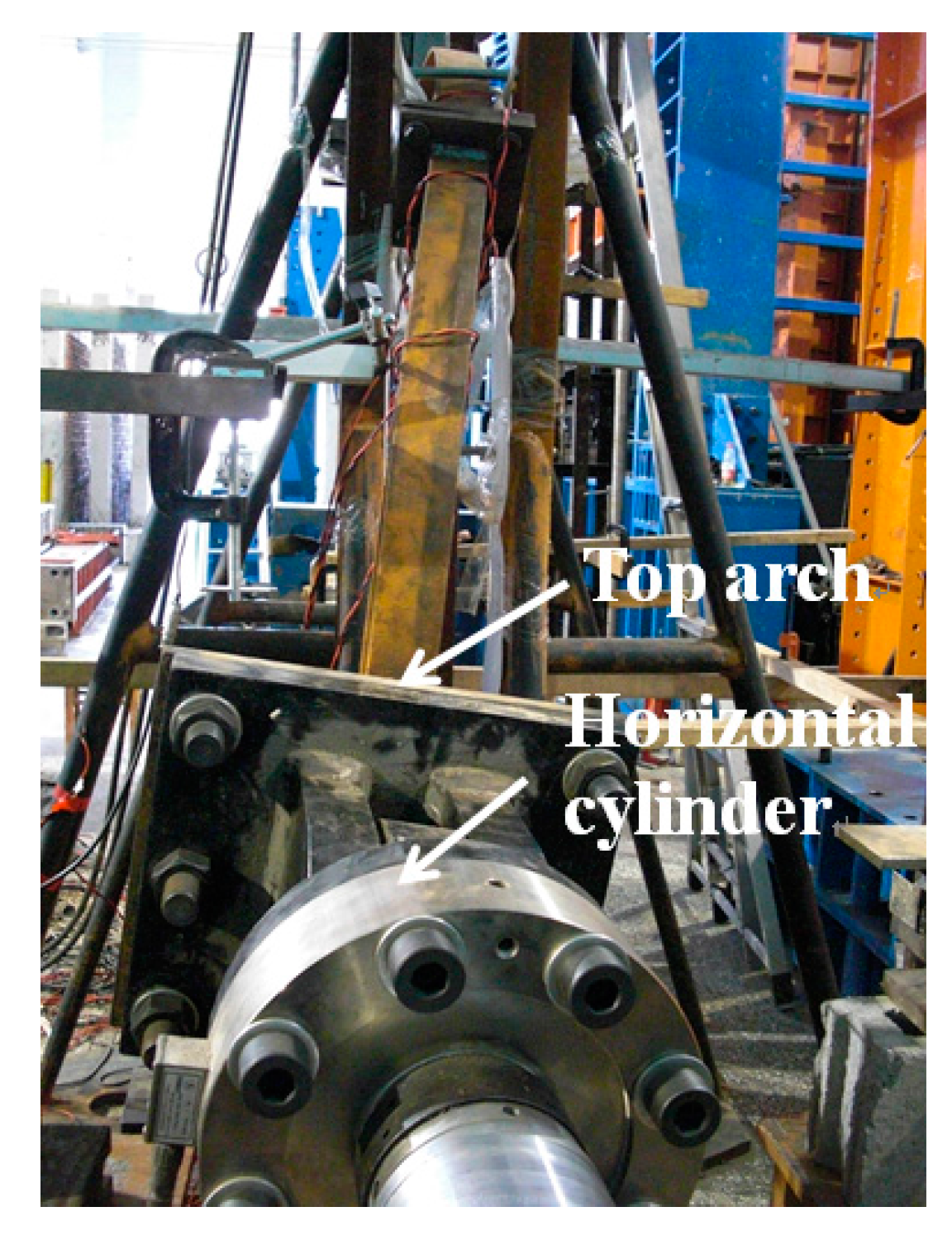
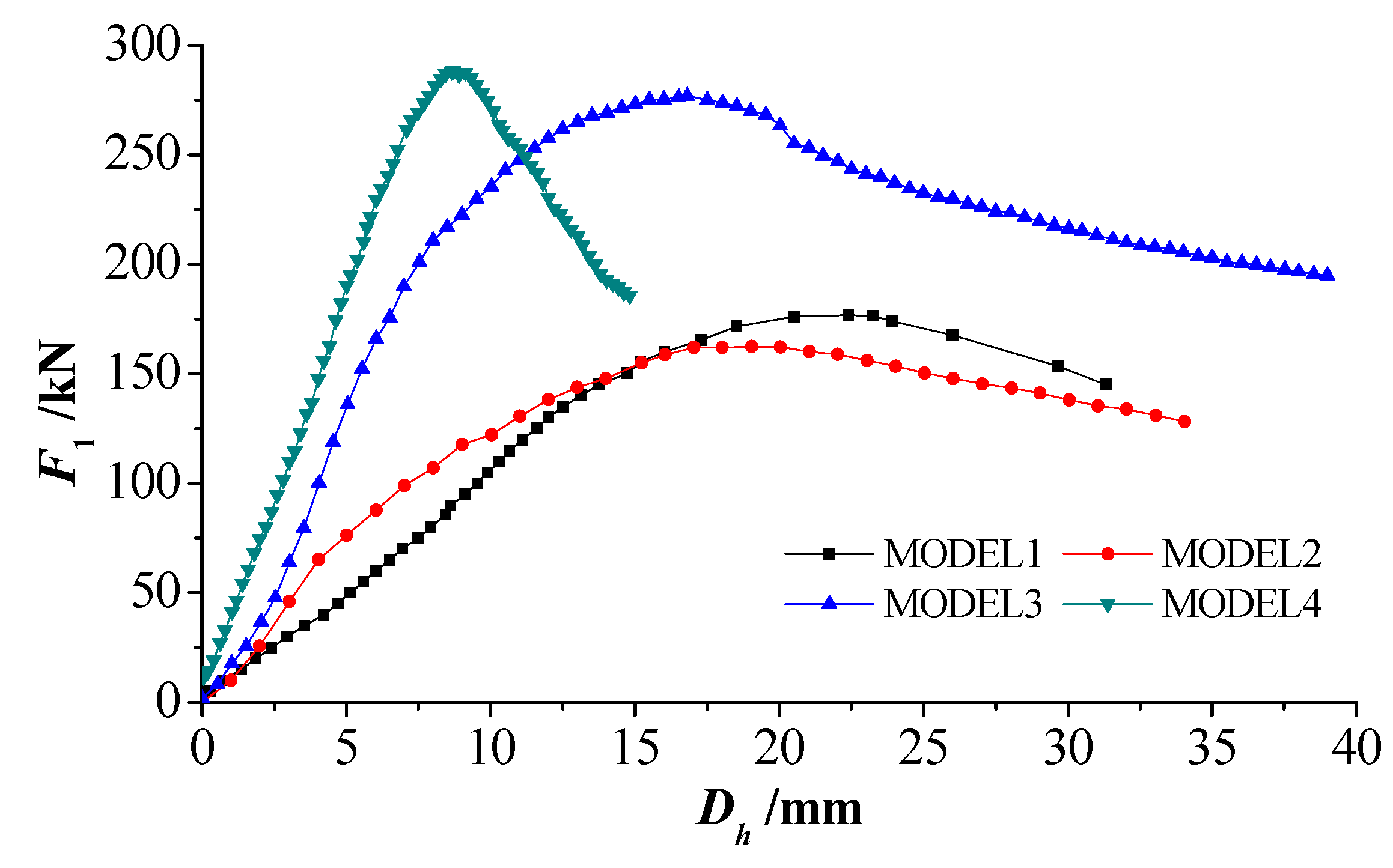
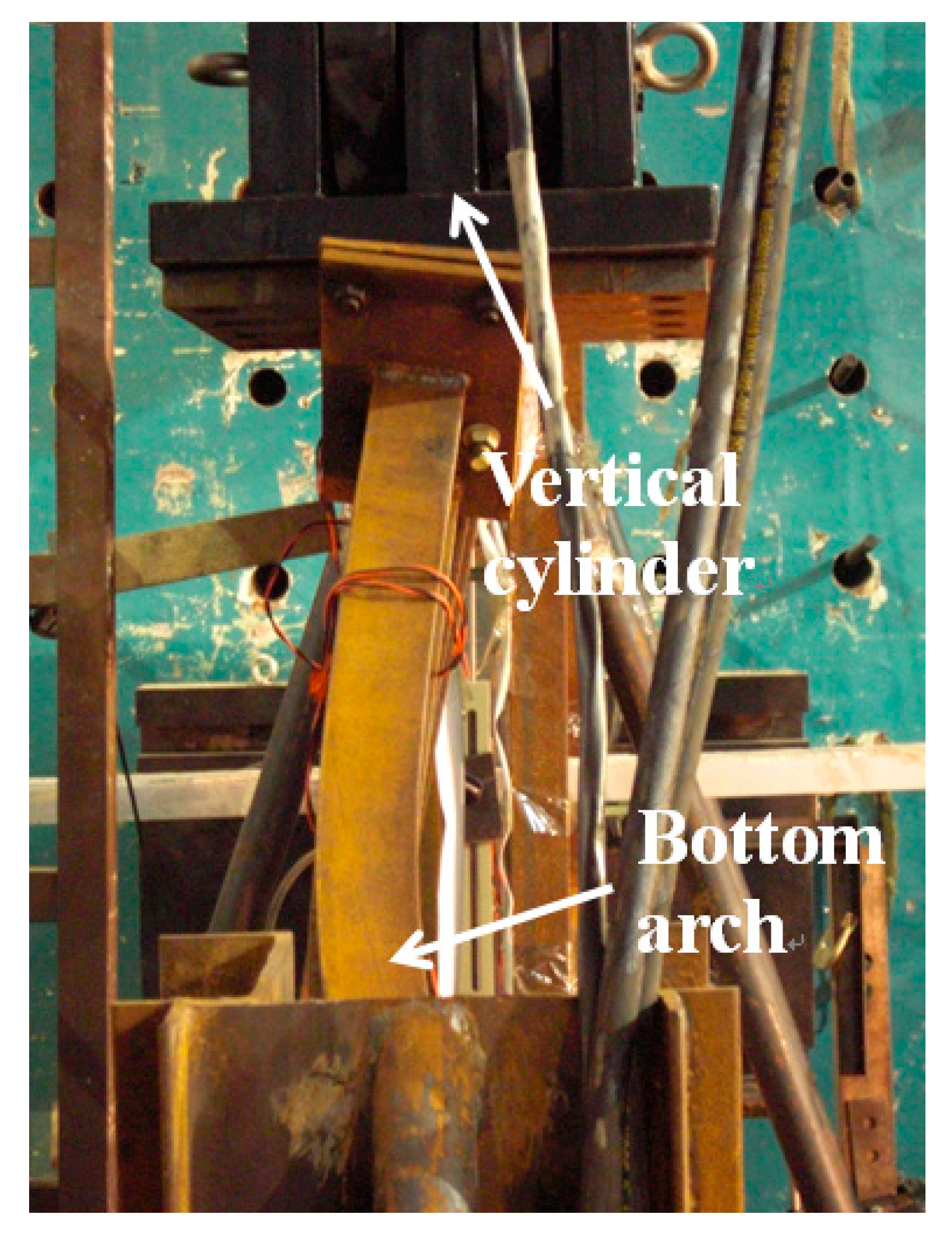
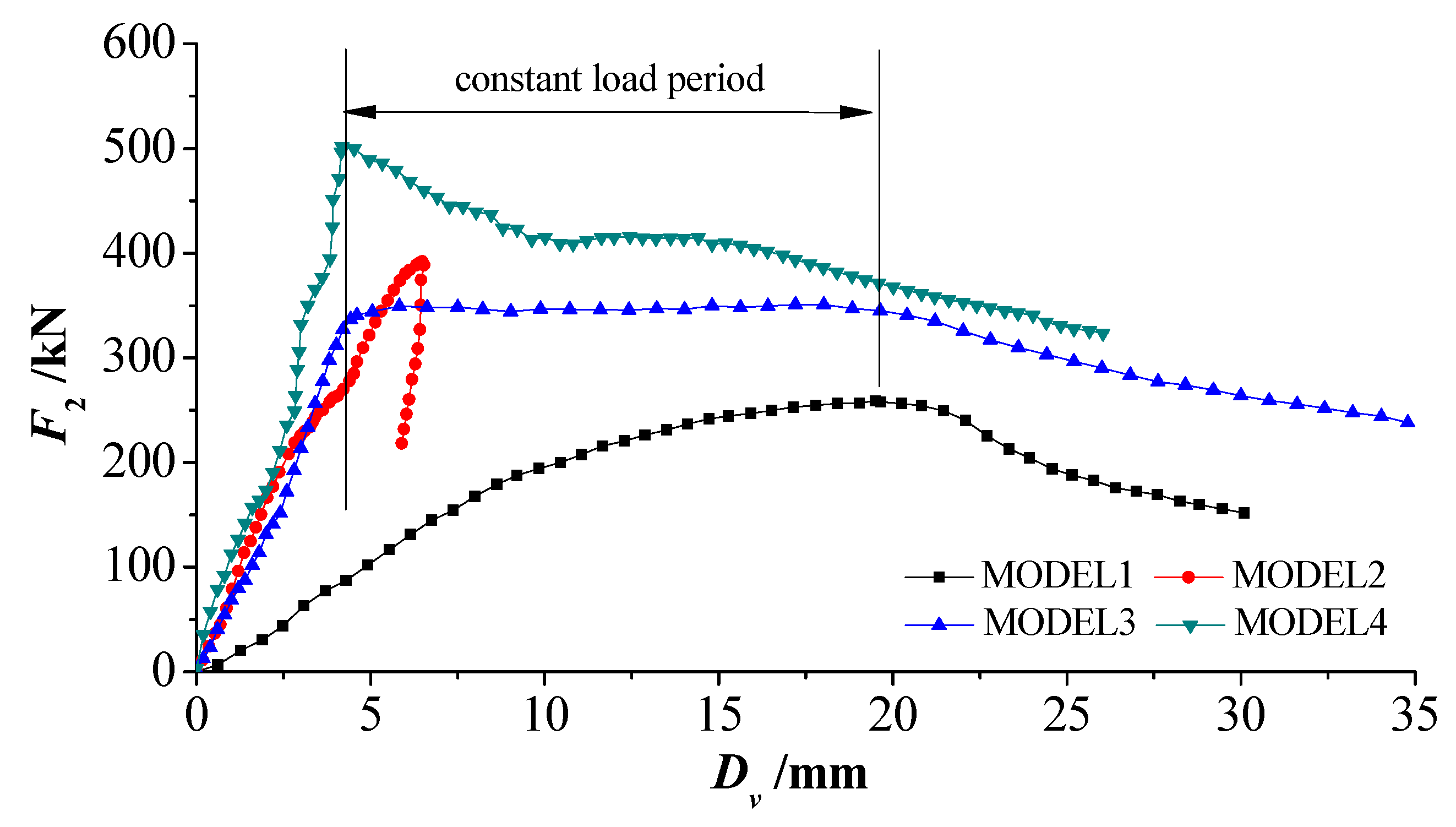
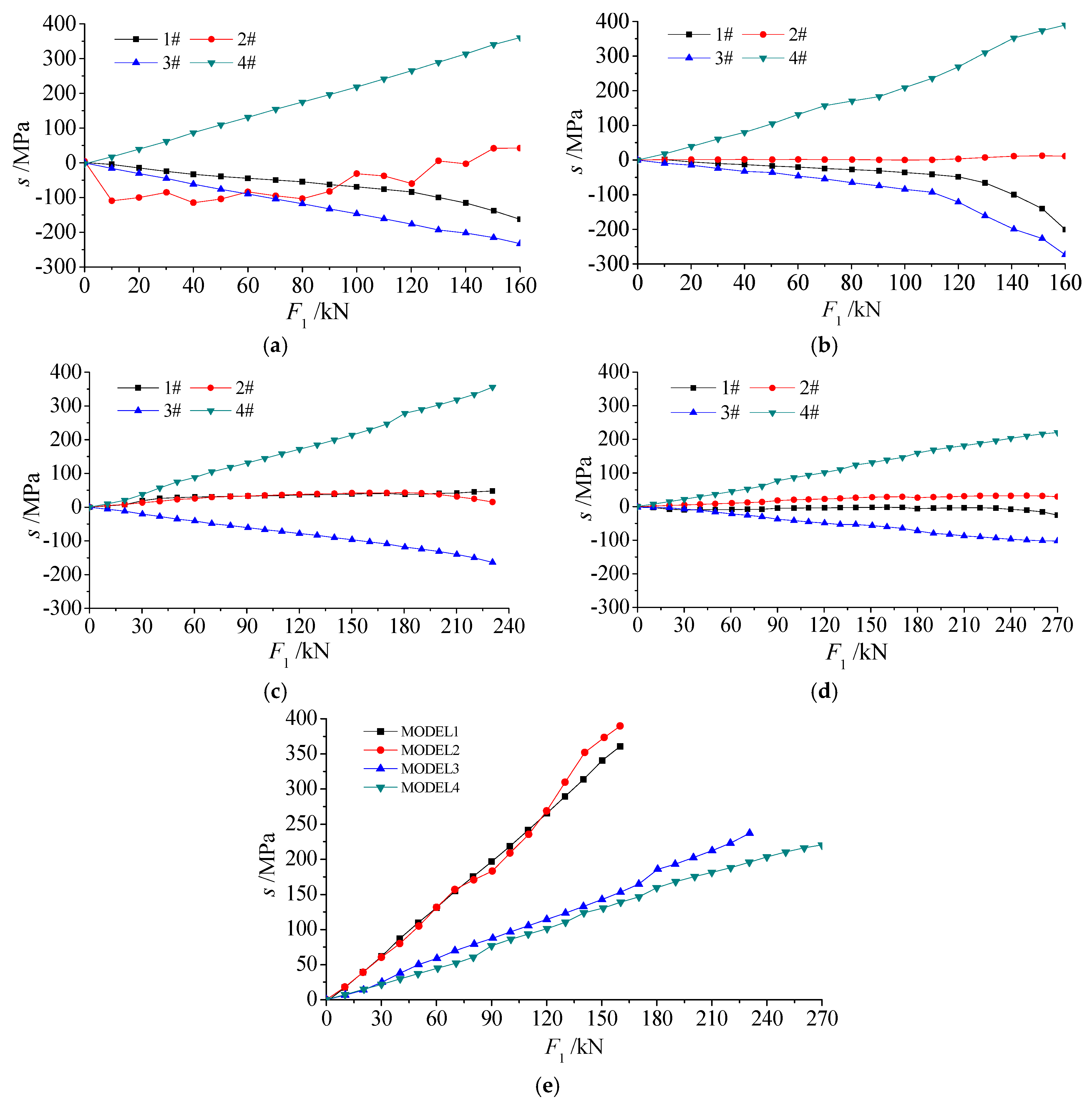


| Pattern | Theoretical Mass m (kg/m) | Sectional Area A (cm2) | Section Thickness at Neutral Axis d (cm) | Moment of Inertia I (cm4) | Elastic Modulus E (GPa) | Section Modulus W (cm3) | Static Moment S (cm3) |
|---|---|---|---|---|---|---|---|
| 36 U-steel | 35.87 | 45.69 | 1.56 | 928.65 | 200 | 141.22 | 330.05 |
| 12.6 I-steel | 14.223 | 18.118 | 0.5 | 488 | 200 | 77.5 | 44.985 |
| Results | Model 1 | Model 2 | Model 3 | Model 4 |
|---|---|---|---|---|
| MBC (kN) | 176.8 | 162.5 | 277.0 | 288.3 |
| Horizontal Stiffness fh (kN/mm) | 10.746 | 9.878 | 31.508 | 36.678 |
| Results | Model 1 | Model 2 | Model 3 | Model 4 |
|---|---|---|---|---|
| MBC (kN) | 258.8 | 392.1 | 351.0 | 501.9 |
| Vertical Stiffness fv (kN/mm) | 21.831 | 78.069 | 76.766 | 80.604 |
© 2017 by the authors. Licensee MDPI, Basel, Switzerland. This article is an open access article distributed under the terms and conditions of the Creative Commons Attribution (CC BY) license (http://creativecommons.org/licenses/by/4.0/).
Share and Cite
Yang, R.; Li, Q.; Li, Q.; Zhu, X. Assessment of Bearing Capacity and Stiffness in New Steel Sets Used for Roadway Support in Coal Mines. Energies 2017, 10, 1581. https://doi.org/10.3390/en10101581
Yang R, Li Q, Li Q, Zhu X. Assessment of Bearing Capacity and Stiffness in New Steel Sets Used for Roadway Support in Coal Mines. Energies. 2017; 10(10):1581. https://doi.org/10.3390/en10101581
Chicago/Turabian StyleYang, Renshu, Qinghai Li, Qing Li, and Xianlei Zhu. 2017. "Assessment of Bearing Capacity and Stiffness in New Steel Sets Used for Roadway Support in Coal Mines" Energies 10, no. 10: 1581. https://doi.org/10.3390/en10101581




